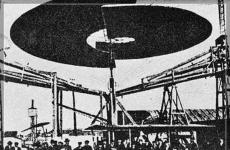We build a house on wheels with our own hands. Do-it-yourself trailer cottage: getting ready for a long journey! Drawings to make the trailer house collapsible
If you decide to make your own motorhome, you will need some basic knowledge, tools, a lot of patience and even more free time. And, of course, reliable vehicle to build a camper.
This article contains some photos of a do-it-yourself motorhome built on the basis of a Volkswagen car. Most of the tips can be applied during the construction of motorhomes based on other cars.
Before you begin, it is very important to read the next paragraph!
IMPORTANT! Before you start creating a camper with your own hands, it is necessary to legalize the implementation of such a procedure. In this case, you can prevent various legal difficulties. The rules vary by country, so we cannot publish uniform recommendations on this matter.
First steps
Building a house on wheels with your own hands consists of the following steps:
- outdoor work
- Internal work
- Water works
- Gas and electricity
- Furniture
- Other
If the van is operated by only two people, there will really be a lot of space. If you are planning a trip of 3 or more people, you need to consider the number of seats. Remember that seats should be equipped with appropriate seat belts.

How many places to sleep will you need? One option is to arrange bunk bed for kids. If you have a reserve of space under the roof, you can make a “drop-down” bed.
At this stage, you should have a clear plan further action. Of course, you can improvise, but it's much easier to have a well thought out plan on paper.
outdoor work
The first thing to do when preparing a base vehicle is to thoroughly clean the inside of the vehicle.

At this stage, you also need to consider the shape of the body as a whole. It's time to deal with damage to the body, rust. Local or full car painting will help.
As a rule, vans do not have windows, so you can think about installing them. They are needed to ensure the flow fresh air and hits sunlight inside the motorhome. Windows are different forms and sizes, the choice depends on your preferences and body features.
During the construction of a motor home, you will have to make several holes in the car body. These are openings for ventilation, gas outlet (in case of leakage), heater exhaust gases, water fillers, etc. Some of them can be done later, but it's much easier to resolve the issue now if you know exactly where they will be.

Remember to apply a primer to all areas where bare metal appears to prevent corrosion.
Build your own motorhome the right way!
Internal work
Most likely, the van will have a partition behind the front seats. Some partitions are fastened with screws, others are welded to the body. "Bulgarian" will help to solve the problem.

Remember to use protective equipment. sparks can leave unpleasant spots on glasses that cannot be removed.
The most interesting begins. The insulation layer is very important as it will protect your camper from external noise and temperature. There are many materials that can be used. The choice is up to you.
In this case, it was used material Armaflex. It should be cut into pieces and glued. The main point is moisture protection. If a insulating material does not protect against moisture, it should not be used.
It is necessary to prepare insulating material, lightweight and waterproof plywood, as well as soft and flexible carpeting.

Thicker plywood should be used for the side covers, as furniture will be installed on them in the future.
Use an adhesive or sealant with a wide temperature range to secure the insulation and carpet on the side walls. Because the camper will be exposed to both sub-zero temperature, and hot summer sun. The operation of the heating will also be affected. In the case of using low-quality glue, the work will have to be redone again after a while.
Where to begin? Start sheathing the motorhome, starting from the roof and ending flooring. First, we mount the insulating and facing layers on the ceiling, then move on to the side panels.
Use wood planks on the floor to create enough space for insulation. The slats are fixed to the floor with an appropriate sealant. Then a layer of insulation is laid, after which it must be covered with plywood. Plywood is fastened with sealant or screws.

Remember about water supply, as well as the need for laying electrical cables and gas pipes. Wires and hoses can be run through insulation or under plywood covers if you already know where all the appliances will be installed.
Water works
The mobile home must have a supply of cold running water. To do this, two cans of water are installed under the sink. Submersible pump supplies water to the faucet.
If you need warm water, additional sink or shower, the system will be more complex. You can install large water tanks in another place, for example, under the van. You will need hoses to connect the entire system.

When you make your own motorhome, you are only limited by your imagination.
Don't forget about sewage. You can mount an appropriate tank under the car, or run a hose through the floor to drain water into a portable tank or regular bucket.
Remember that used water smells terrible in summer and freezes in winter. Therefore, you need to get rid of it as soon as possible, so a bucket can be an ideal solution.
How about a toilet? You can install one of the handy portable toilets.
Gas and electricity
IMPORTANT! Gas supply hoses and electrical wiring must only be installed by qualified personnel! If installed incorrectly, they can be a serious hazard. Make your own motorhome, but don't put other people at risk.

Propane in the camper can be used for cooking, heating, as well as connecting the refrigerator. You can do without it by using electric stove and a refrigerator, as well as an autonomous heater Webasto.
The gas cylinder must be stored in a separate place with holes in the bottom. Why should there be holes at the bottom? Because propane is heavier than air, so it will always go down.
You can even make a valve to connect the gas stove outside the car so that you can cook outside of the van in the future.

Again, build the camper properly for your own safety!
Electricity required to run all devices designed for 12V. The system consists of a battery, charger/converter, control panel and lots of wires.
Do not forget about the external connector for charging the motorhome battery from a conventional power supply (110V or 220V). You can also use it at home by charging the battery during winter storage.
In order to determine how much battery capacity you need, you will have to run simple calculations. Let's say you'll use the following:
- Halogen lamps: 2×20W 2 hours per day = 80 Wh
- Refrigerator: 45W 12 hours a day = 540 Wh
The total power consumption is 620 Wh per day. Now divide 620Wh by 12V and you get 52Ah. This is your daily power consumption. As a rule, a 100Ah battery will last for about two days of battery life.
Make calculations considering the energy consumers you use. This will help you get average daily electricity consumption figures.

Gas and electricity are very important issues to consider when building a camper. If you plan to operate a motorhome for traveling away from civilization, autonomy should be maximum. Take your time, think carefully and calculate everything.
Furniture
In this matter, you are also not limited by anything. You can boldly realize your dreams. There are many ways to make and install furniture.

Sometimes quite suitable furniture is found at various disassemblies, we advise you to look. Good offers sometimes appear on online auctions, and furniture is sometimes sold at a very affordable price.
You can also design everything from scratch. Some firms sell ready-to-install parts, veneered. You only have to apply varnish (if necessary) and install furniture. You can also contact a professional to help you with this matter.
Homemade cottage trailer made from a car trailer: photo of a camper built with detailed description, also a video showing a motorhome.
We decided to build a small residential house on wheels in order to go to nature in our car. Since we didn’t have camper drawings, we decided to make a removable module for the factory trailer (so that there were no problems with re-registering the vehicle).
Bought for this boat trailer of the Kurgan plant(only they don’t specify in the TCP what kind of trailer it is. just a trailer, other manufacturers indicate that this is a boat trailer and you can’t put a house on it).
The dimensions of the module corresponded to the dimensions of the trailer - 1400 x 2400 mm. Naturally, the removable module must be durable, and for our roads a plywood house will definitely not work, we had to weld a steel frame.
The base is welded from a 60 x 30 mm profile, the walls and ceiling from a 20 x 20 mm profile. On the pipe bender, 2 identical arcs were bent.
The most difficult thing was to think over the doors, it took us 1/3 of the time spent on the doors. Those who were interested in this topic, for any reason, saw factory doors, ventilation hatches on American trailers, gas stoves, sinks, heaters, etc. etc. There is only one problem: cost. one factory door costs about 700-800 bucks (and you need 2 of them), a sunroof with an exhaust hood is about 300-400 bucks, I didn’t even look at the sinks and stoves, and so it became clear that we would choose from what we would find in household stores .
As a result, the doors were made by ourselves, because with our course the budget for the doors alone went out more than 100 thousand (on alik, ebay, in Europe, America, Russian online stores - the prices are about the same).
Doors decided to do with power windows, because. This is the easiest way in our opinion. It makes no sense to describe the whole process, I will only say that making the doors was very dreary. but at cost they came out 5 rubles each door, taking into account everything. the savings were worth it
Outside, the case was sheathed with 0.8 mm aluminum sheets, they were looking for specially large sheets so that they could be covered with one sheet without joints. As a result, we found AMTs2 sheets measuring 1500 x 3000 mm, which suited us perfectly.
Now I would choose a composite material for building cladding, 4 mm thick (who does not know, these are 2 sheets of 0.4 mm aluminum, and between them a special composite that ideally withstands all weather phenomena).
They glued aluminum onto a plywood substrate, riveted around the perimeter and sealed all joints. It was possible to leave the trailer aluminum, but initially they wanted blue on the outside, so they ordered a vinyl film for wrapping the vehicle in a printing house and fitted it on top.
Many people ask about the refrigerator. There is no refrigerator, and there cannot be, because. The module is removable and has its own car battery. The wiring of the module is completely autonomous, and is not connected to the wiring of the car and the trailer in any way. Therefore, you can't connect a refrigerator here. Although I do not understand the problem if it can be put in the trunk of a car.
We also made 2 220V sockets in the residential area, a 400W inverter, enough for charging and for a TV. Lighting is LED throughout.
Water is supplied from a canister by a fountain pump, not very powerful, but economical.
They made a niche for the countertop under the kitchen, it seemed very convenient, but in fact the top and bottom ribs were from a 15 x 15 profile, a very flexible and not reliable profile. As a result, the niche bent a little and the chipboard table did not fit in there, it had to be made of plywood.
After assembly, the trailer was tested by Karcher at all joints, slots, etc. 100% tightness.










The cost of building a cottage trailer.
We started building the camper in May 2015 and finished in June 2016. We work with a friend in shifts, i.e. per week 2-3-4 days could devote to the trailer. Very hung with the decoration of the kitchen and doors. If you expect to collect in 3 months - plus a triple time.
In terms of finances: everything was bought new, nothing used was used. The trailer itself cost 44 thousand, and about 110 thousand was spent on materials. fixed everything, up to the gloves, so the price is close to the real one. You can do it cheaper, but you should know in advance.
By weight: trailer + module weighs about 600 kg, the module itself is about 460-480 kg. Heaviness added a large number of Chipboard, who will do it - look for a lighter material for partitions.
The passenger car 1.4 Octavia drags the trailer with a bang. On the highway, it accelerated to 130 km / h, the trailer is not felt at all, the streamlined shape practically does not slow down. consumption increases by 1-2 liters. On a bad road, more than 90 is difficult to drive, after all, the weight is not small, it twitches the car. But 80-90 is quite acceptable for such a trailer. I drove through the fields, along dirt roads, the trailer never struck anywhere.

Video, which tells in detail about a homemade mobile home.
Perhaps there are very few people who would not like to travel and at the same time spend the night at home without using the services of hotels or hotels. Many will say that this is impossible and any trip is accompanied by a hotel room. However, there is a solution - a motorhome or a motorhome. You have probably seen such mobile structures in foreign films. And this is not strange, because let's say in America, according to statistics, every 3 inhabitants have a house on wheels.
Such a house is not only convenient and comfortable, but also saves a lot. cash, since the question of finding housing disappears. You can talk about the advantages of a motorhome for a long time, and there are really a lot of them. However, there is one drawback - a motorhome car is not a cheap pleasure. But if you have patience and diligence, there is a way out - to build a mobile home on wheels with your own hands.

The main need for such a house is travel, which you can safely send with your family and even small children. The motorhome is also useful for business trips, you do not have to look for hotels, book rooms, collect luggage and carry it with you.
The main thing is that the driver is experienced, with a good driving experience and, of course, with a positive attitude towards this type of transport.

Home on wheels: what you need for comfort
Although the house will be in the form of mobile housing, this does not mean that it should not be comfortable and satisfy the minimum needs of the owners.
Home lighting
To supply light to a mobile home, you will need:
- battery type;
- charger;
- wiring system for subsequent electrical wiring;
- control panel for power supply.

Heating for the home
Several types of heaters can be used to heat a home, it can be offline view and gas bottle. The use of gas is preferable, since in addition to heat it will provide the opportunity for cooking.
If you have chosen gas heating, then you will have to seek help from a specialist. Of course, building everything with your own hands from start to finish is commendable, but you should remember about the safety of passengers.
Air (ventilation) for the home
Highly important point is ventilation, especially when using gas. In this case, there should be several holes, and one of them will be as low as possible.

For comfort: water, bathroom, kitchen
No housing will be comfortable if it lacks basic amenities. Think carefully about where exactly the kitchen, mini-sized portable dry closet and shower will be located. Also do not forget about water tanks and pumps for it.

The water that will be drained is best sent to a large bucket under the body. To do this, you can use a special hose that should be laid in the floor.
Furniture for motorhome
Certain difficulties may arise with furniture, since it should be as compact as possible. For such housing, folding furniture is used, it is attached to the walls. In most cases, it is possible to purchase such furniture only on order, which is quite expensive. But if it is possible to do it yourself, then this will save a lot of money.

Extras: doors, windows
As for windows, it is better to make at least 2, so you can save energy and not turn on the light during the day.
It must be taken into account that if the house is being built from a trailer, then the width and height, of course, should not exceed the dimensions of the car. If you are the owner of a domestic minibus, which has not been to your liking for a long time, then you can safely use it as the main material for mobile housing. First, you need to thoroughly clean it, remove unnecessary seats, jet upholstery, get rid of everything superfluous. After clearing, you can start making the necessary holes (for windows, ventilation, wires).
We build a motorhome from the GAZelle
Is it difficult to build a motor home on the basis of a conventional car trailer? What materials can this trailer house-cottage be built from? What are its minimum dimensions? What interior layout will allow the most efficient use of inner space? Let's try to find answers to this list of questions.
Goals
small country cottage- probably the most common hobby on post-Soviet space over the last half century. The area of cities is growing every year, and the sites naturally move away from the center settlements. Distances are sometimes measured in tens of kilometers; The most comfortable way to overcome them is to drive your own car.
However, transform small plot instead of permanent residence not all summer residents are ready. The maximum that an average urban family can do is to spend the night on their site once a week. Building a capital house for the sake of this overnight stay is a dubious undertaking; Sleeping in a car is very uncomfortable...
For summer residents who have basic skills in working with power tools, home-made trailers are often the way out.

We have to study one of these structures, having become acquainted with the materials used and constructive solutions.
Acknowledgment: The photos used in this article were kindly posted by one of the regulars of the League of Caravaners forum.
The work of the author was reduced only to the clarification of some technical subtleties.
Material selection
In most cases, a single-axle trailer with a maximum load of no more than a ton becomes the basis on which a compact trailer-cottage-caravan is built. Taking into account the weight of household items and a couple of people, our choice is a cottage trailer up to 750 kg in weight.
The weight limit leaves its mark on the choice of material.
- We will make the frame of the building from a pine bar with a section of 50 mm.
- Walls - from 10 mm plywood (moisture resistant or impregnated, which reduces the hygroscopicity of the material and prevents it from rotting); floor - from 12 mm. It is also used for building inside.
- The outer skin is galvanized steel. The sheets are hemmed to the frame bar with self-tapping screws; overlaps are additionally sealed silicone sealant. The outer corners are reinforced with an aluminum corner - again sealed with silicone.

- What to choose as a heater laid between the inner and outer layers of plywood - let the reader decide. Here is a comparative thermal conductivity of popular heaters:
Nuance: glass wool will inevitably caking over time.
It is better to use hard insulation.
Dimensions
A reasonable minimum size of the trailer required for our purposes is 2300x1600 mm. Such dimensions will allow you to build quite comfortable inside sleeping place for two people and leave some space for a table under the washbasin and / or gas stove.
A two-axle trailer-dacha will provide much more comfort; however, the price of such a trailer will be twice - three times more. Its dimensions (up to 4.5 meters in length) allow you to build a full-fledged toilet room.
A reasonable minimum height of a structure is generally 2 meters. The height can be adjusted depending on the dimensions of the owners: it is clear that a person of very tall stature does not want to constantly cling to the ceiling with the top of his head.
Construction
So let's get started. How to build a cottage from a trailer with your own hands?
Floor, bottom rail
- Boards are completely dismantled. From the trailer there is only a flat platform. If the horizontal base has sufficient rigidity, the floor logs and strapping can be attached directly to it; it is better to scald a thin flexible sheet with a frame made of a professional pipe with a section of 50x25 mm.
- Then, the bottom strapping from the bar, laid around the perimeter, is bolted to the base; side bars are connected by lags with a step of 20 cm (for 12 mm plywood).

As an option, the entire structure can be assembled at the stand and only then pulled to the base of the trailer.
- The logs are attached to the harness with a galvanized corner; the bar must be soaked with hot drying oil twice.
Tip: instead of drying oil heated in a water bath, you can use cold drying oil.
In this case, after applying each layer, the bar is heated with a building hair dryer.
- A heater is laid between the lags; then the floor is covered with plywood, which is attracted by self-tapping screws.
frame
The instructions for assembling the frame are no different from the construction of the lower trim: the bar is connected by corners to self-tapping screws. Before or after assembly, the tree is impregnated with drying oil. Do not be afraid that the frame will not be rigid enough: the sheathing will add structural strength.
Sheathing, insulation
The finished frame begins to be sheathed from the inside. Plywood is attracted by self-tapping screws 32 mm long with a pitch of about 25 cm. Self-tapping screws are only galvanized: in wet weather, black steel will inevitably decorate the walls with untidy rusty streaks.
Three nuances:
- Holes for self-tapping screws are pre-drilled and countersunk so that the caps do not cling to clothing. An alternative is to use self-tapping screws with semi-secret heads.

- Plywood with inside must be sanded before varnishing and after applying the first layer. Any moisture will raise the pile on the top layer of veneer, which will make the surface rough.
The amount of work will be quite large, so it is better to use a grinder - even the simplest, vibrating. If there is no electricity where you are building, there is always a way out: renting a diesel generator for a summer residence costs from 1,000 rubles a day. - The outer side and ends of plywood also need protective impregnation. And in this case the cheapest and practical option- two layers of hot drying oil.
The insulation is fixed in the grooves formed by the frame and inner lining, after which it is sheathed on the outside with plywood proliferated on both sides.

The door is assembled similarly to the walls and hung on galvanized hinges; as a constipation, the usual door lock or a pair of latches - inside and out.
Final stage - exterior finish galvanized. It is fixed with self-tapping screws 25 mm long in increments of 10 cm along all the bars of the frame; then the corners are closed with a corner. Do not forget about the sealant: it will protect the corners and joints from water leakage.

In the photo - the lining is ready for painting.
Window
If you want your miniature house to have skylights, no problem.
- The opening is provided at the stage of frame construction. It is surrounded by a bar with a section of the same 50x50 mm.
- As an external glazing bead, a duralumin corner is used, screwed flush with the outer skin with self-tapping screws. The seat under the corner is pre-coated with sealant.
- A piece of plexiglass cut to the size of the opening sits on the sealant and is fixed from the inside with a glazing bead from the same duralumin corner.
Internal layout
Our choice is a convertible bed-seat and a folding table. The transformation mechanism will make clear pictures.


Useful little things
- An alternative to galvanized plywood outer skin from profiled sheet. According to a similar scheme are often built country houses from block containers.
- Do-it-yourself cottage trailer repair usually comes down to periodic painting of galvanizing. old paint removed with washes. In those few cases where the wheels, fenders or suspension of the trailer are damaged, spare parts for the trailer are bought at the nearest auto shop.

- The easiest way to organize ventilation is to provide a pair of closed doors in the door. mosquito net hatches (bottom and top).
Conclusion
A motor home is a type of transportation that is both housing and a means of transportation. This kind of housing gained its popularity at the beginning of the last century.


By standards, the mobile home should accommodate eight people. Each tenant has his own sleeping place, there is still small kitchen. Other amenities and equipment may vary depending on the specific model, but in most cases there are also:

In more expensive models, there is a bathroom, consisting of (often replacing a chair, which gives several additional meters free space), washbasin and shower. Sometimes mobile homes are equipped with showers.
Note! In a motorhome, the driver and passenger seats are movable, as a result of which, during parking, they turn into an addition to the living space. In the tail, a separate room with U-shaped furniture is often equipped.


Story
Serial production of mobile homes was launched in the last century, although some historians believe that there were earlier makeshift counterparts. They were small vans equipped for human habitation (mainly pastoralists).
The first motor home mounted on a conventional automobile chassis was introduced in 1938 by Jennings.
Varieties of mobile homes
There are several classifications of motorhomes. So, according to the design features, they distinguish:

Depending on the purpose, they are divided into:
- those used as long-term/permanent housing;
- those used for travel.
In the first case, there are more comfortable conditions, while often moving structures are extremely rarely divided into actual living space and a cabin.
Categories

Let's look at each category in detail.
C-class
Small houses designed for short trips. They are usually made on the basis of SUVs, so at night the cabin can be in a double bed (if desired).
B-class
The only difference between it and the C-class is a berth - it is stationary and is located in the tail of the transport. It is very popular among young couples (at least in America).
A-class
Such houses, which look like an ordinary bus, are the most comfortable and, therefore, the most expensive. They are built on the basis of trucks, therefore, in terms of transport classification, they belong to category "C".
They are distinguished by a large windshield, a fixed driver's seat and retractable partitions that form different zones and separate sleeping quarters. Moreover, such structures are autonomous, equipped with a generator, have gas and a large supply of water.
Several additional categories can be distinguished.


About the title
The term “motorhome” (another name is “camper”) often means a car caravan.
Note! B- and C-class trailers are called campers, while motorhomes are exclusively A-class models.
It is also worth noting that in some countries, without exception, motorhomes are called winebago.

It will take a lot of effort and time, as well as the appropriate equipment, to turn a car into a motorhome.

Note! First, this issue should be studied from the point of view of legislation. Different registration organizations perceive homemade motorhomes differently, and it will be unpleasant if the transport ends up being illegal.
Stage 1. First, the number of residents is determined and, based on this, a vehicle and an internal "stuffing" are selected. A detailed design plan is drawn up - this can be done on paper, but it is better to use a computer.

Stage 2. Next, the car body is cleared. If dents are found, they are removed and the peeling paint is scraped off. Several windows are equipped (if they were not) in the housing for lighting and fresh air.

Stage 3. Ventilation holes and valves for gas supply are cut out. All areas of "bare" metal are coated with a primer to protect against corrosion and aggressive environmental influences.
Stage 4. The house is finished with thermal insulation material.



Note! To do this, you must use only quality materials saving is highly undesirable. In addition, the material from which the hardware (metal fasteners) are made should be similar to the metal of the car body - this is for additional protection against rust.
Stage 5. Get off inner surface motorhomes.

- carpet covering;
- waterproof plywood.
Thick panels with stuffed planks for furniture mounting are inserted into the side walls. It is characteristic that at first it is better to level the ceiling, and only after that go to the walls.



Stage 6. After installing the furniture, you should take care of the water supply. To do this, you can install several canisters of water under the sink and install small pumps. In addition, you can put large tanks - for example, for taking a shower.



Note! Do not forget about wastewater - another tank is installed for this. As a toilet, you can use the usual garden structure.
Stage 7. For cooking and heating, as noted earlier, it is better to use propane gas. The cylinder is located in the lower part of the body, as well as an additional hole for ventilation. This is explained quite simply: propane weighs more than air, so in the event of a leak, such safety measures will prevent sad consequences.

Stage 8. It remains only to take care of the power supply. The best option– a powerful rechargeable battery equipped with an external outlet for charging.







Mobile home from an old trailer

A trailer-trailer costs about 500,000 rubles. The amount is impressive, so if you have the opportunity to purchase an old car trailer, you can build a small motorhome with your own hands. This will require:
- trailer (necessarily with a strong chassis);
- wooden elements (slats, bars, wagon boards);
- plywood;
- metal profile (for roofing);
- fittings made in the same style;
- set of appropriate tools.
Manufacturing technology
Such a motorhome will be a trailer with in the back. By the way, it is better to make a bed for the entire width of the structure - this way it will connect the side walls and thereby increase rigidity. The bay window will be made later and equipped with an individual unit. The door is installed Dutch type - it will consist of two halves.

Stage 1. The trailer is disassembled, the chassis is carefully cleaned and covered with anti-corrosion paint. From pine boards a frame is being built, supports are cut in appropriate places.
Stage 2. A frame is constructed from slats with a section of 2x2 cm, an oak rail with a section of 3x3 cm is additionally installed in each corner. From above, the frame is tied with a horizontal rail.
It is advisable to use lining of various thicknesses:
- for side walls - 6 mm;
- for front and rear - 19 mm.
Note! For thermal insulation, you can lay the lining in two layers.
Stage 3. The floor is covered plywood sheets. Poplar beams are used for the roof - they are screwed along the frame in increments of 30 cm. Plywood is fixed on the beams, on top of which a moisture-resistant material and a metal profile of a small section are laid.


Stage 4. There will be only one window in the case (if the door is not taken into account) - in the upper part of the back wall. The window is preferably made in the form of a bay window.
The door lock in such designs is located below, but you can put one more - additional - on top. In addition, the door is equipped with a small casement window.

Stage 5. It is recommended to equip a table that slides out from under the bed (as was once the case on British trains). For this, special lockers are formed under the bed. By the way, the lower space can also be used as a bed.
In addition, shelves and a removable ladder are built from wood.
Letter of the law
No additional permit is required if the dimensions of the motorhome will not exceed:
- 400 cm high;
- 255 cm wide;
- 100 cm long (excluding the part that does not protrude beyond the trailer).
If the dimensions are larger, then the motorhome is transported according to special rules (flashing lights, escort, etc.). Of course, this only applies to trailer trailers.
Setting up a mobile home business

At the construction of motorhomes, you can organize own business. There are four options for developing such a business.
Option number 1. Making houses for sale summer holiday or living in a country house. This will not require serious material costs, since the houses will be of a simplified design - for example, without insulation.
Option number 2. Rent out motorhomes. It's relative new business, and everything new can be taken very expensive. The number of motorhomes in this case is increasing as the customer base grows.
Option number 3. Make food trucks or shops.
Option number 4, he is the most interesting. It consists in the creation of a car park and its further use as a hotel. The main thing here is to divide trailers into budget, premium and middle class.
For a more detailed acquaintance with the construction technology, check out the thematic video.
Video - Do-it-yourself motorhome










